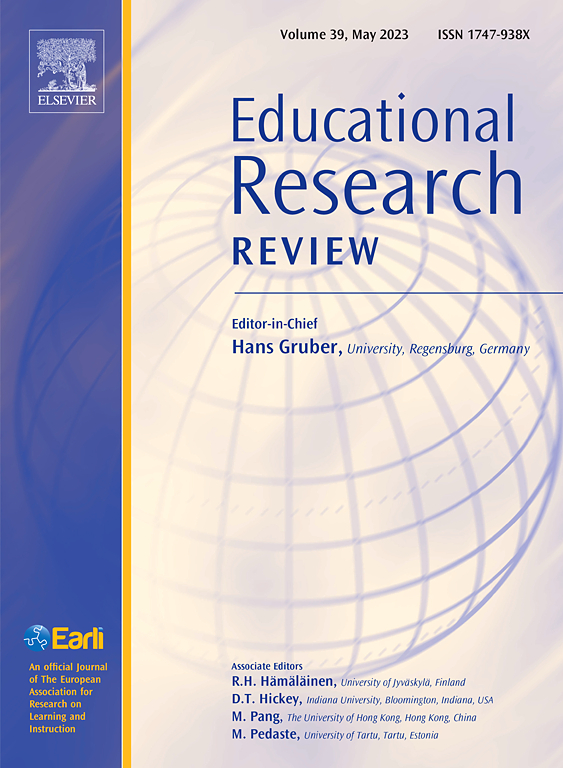K-12教育中设计思维的研究综述
IF 10.6
1区 教育学
Q1 EDUCATION & EDUCATIONAL RESEARCH
引用次数: 0
摘要
设计思维(DT)在 K-12 教育中引起了越来越多的关注。然而,有关 K-12 教育中设计思维的研究尚未得到全面的回顾。本综述研究试图弥补这一领域的空白。按照 PRISMA 准则,本综述研究考察了 40 项有关 K-12 教育中 DT 的实证研究,重点关注四个关键方面:(1) 研究领域;(2) 将 DT 纳入 K-12 教育;(3) 研究方法;(4) 综述研究的报告结果。在第一个方面,确定了主要分析主题为参与者视角、教学干预、学习评估和设计机制。就第二个方面而言,研究发现,这些研究主要是在中学设计、技术、工程和 STEM(科学、技术、工程和数学)教育的背景下进行的,持续时间从 3 天到 9 周不等。在第三个方面,这些研究通常对文件进行定性分析,并进行问卷调查、访谈和观察。这些文章介绍了调查问卷、在线游戏和评估 DT 的量表的开发情况。就第四个方面而言,研究结果表明,DT 受到大多数参与者的欢迎,它能够优化学习过程,有助于促进学生的学习。不仅可以通过 DT 课程发展 DT,还可以通过编程学习发展 DT。通过时间分配、模式和迭代序列探索,解释了 DT 的有效途径。根据研究结果,我们可以得出这样的结论:DT 在 K-12 教育中仍处于早期发展阶段,因此 DT 研究尚未与学科内容学习广泛结合起来。在 K-12 教育中,需要对各种 DT 元素支持的学科内容学习、基于设计机制的教学和技术支持的评估进行更多的研究,以影响 DT 的教育实践。本文章由计算机程序翻译,如有差异,请以英文原文为准。
Review of research on design thinking in K-12 education
Design thinking (DT) has drawn increasing attention in K-12 education. However, research on DT in K-12 education has not yet been comprehensively reviewed. The current review research attempted to bridge this gap in the field. Following the PRISMA guidelines, this review examined 40 empirical studies on DT in K-12 education, with specific emphasis on four key aspects: (1) research areas, (2) incorporation of DT into K-12 education, (3) methodologies, and (4) reported findings in reviewed studies. In terms of the first aspect, the main themes to analyze were identified as participant perspective, instructional intervention, learning assessment, and design mechanism. In terms of the second aspect, it was found that studies were conducted primarily in the context of design, technology, engineering, and STEM (Science, Technology, Engineering, and Mathematics) education in middle schools and durations ranging from three days to nine weeks. In terms of the third aspect, these studies typically carried out qualitative analysis of documents and administered questionnaires, interviews, and observations. The articles described the development of questionnaires, online games, and scales to evaluate DT. In terms of the fourth aspect, the findings showed that DT was welcomed by most participants, and it was capable of optimizing learning processes and helped promote student learning. DT can be developed not only through DT courses but also through programming learning. The effective way to DT was explained through time allocation, modalities, and iteration sequence exploration. Based on the findings, it may be concluded that DT is still in an early development stage in K-12 education, and so research on DT has not yet been broadly established with academic content learning. More studies on subject content learning supported by various DT elements, instruction based on design mechanisms, and technology-supported assessment in K-12 education are needed to impact the educational practice of DT.
求助全文
通过发布文献求助,成功后即可免费获取论文全文。
去求助
来源期刊

Educational Research Review
EDUCATION & EDUCATIONAL RESEARCH-
CiteScore
19.40
自引率
0.90%
发文量
53
审稿时长
57 days
期刊介绍:
Educational Research Review is an international journal catering to researchers and diverse agencies keen on reviewing studies and theoretical papers in education at any level. The journal welcomes high-quality articles that address educational research problems through a review approach, encompassing thematic or methodological reviews and meta-analyses. With an inclusive scope, the journal does not limit itself to any specific age range and invites articles across various settings where learning and education take place, such as schools, corporate training, and both formal and informal educational environments.
 求助内容:
求助内容: 应助结果提醒方式:
应助结果提醒方式:


